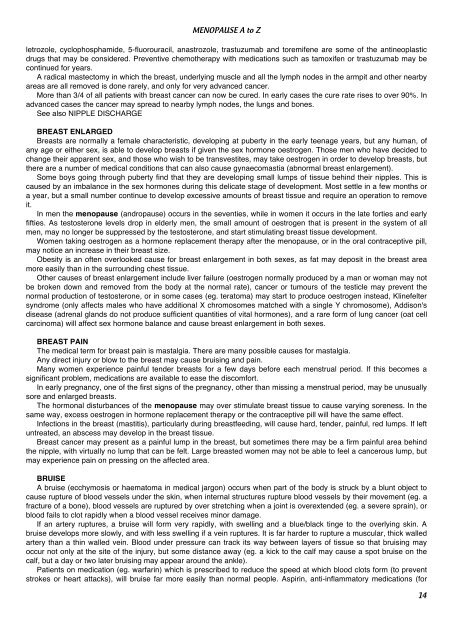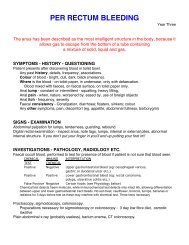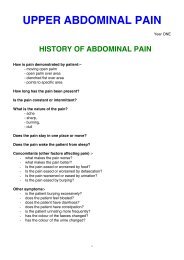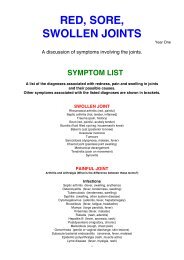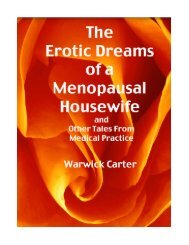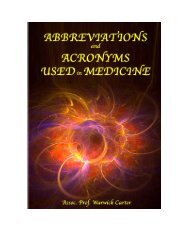Menopause A to Z.pdf - Medwords.com.au
Menopause A to Z.pdf - Medwords.com.au
Menopause A to Z.pdf - Medwords.com.au
You also want an ePaper? Increase the reach of your titles
YUMPU automatically turns print PDFs into web optimized ePapers that Google loves.
MENOPAUSE A <strong>to</strong> Z<br />
letrozole, cyclophosphamide, 5-fluorouracil, anastrozole, trastuzumab and <strong>to</strong>remifene are some of the antineoplastic<br />
drugs that may be considered. Preventive chemotherapy with medications such as tamoxifen or trastuzumab may be<br />
continued for years.<br />
A radical mastec<strong>to</strong>my in which the breast, underlying muscle and all the lymph nodes in the armpit and other nearby<br />
areas are all removed is done rarely, and only for very advanced cancer.<br />
More than 3/4 of all patients with breast cancer can now be cured. In early cases the cure rate rises <strong>to</strong> over 90%. In<br />
advanced cases the cancer may spread <strong>to</strong> nearby lymph nodes, the lungs and bones.<br />
See also NIPPLE DISCHARGE<br />
BREAST ENLARGED<br />
Breasts are normally a female characteristic, developing at puberty in the early teenage years, but any human, of<br />
any age or either sex, is able <strong>to</strong> develop breasts if given the sex hormone oestrogen. Those men who have decided <strong>to</strong><br />
change their apparent sex, and those who wish <strong>to</strong> be transvestites, may take oestrogen in order <strong>to</strong> develop breasts, but<br />
there are a number of medical conditions that can also c<strong>au</strong>se gynae<strong>com</strong>astia (abnormal breast enlargement).<br />
Some boys going through puberty find that they are developing small lumps of tissue behind their nipples. This is<br />
c<strong>au</strong>sed by an imbalance in the sex hormones during this delicate stage of development. Most settle in a few months or<br />
a year, but a small number continue <strong>to</strong> develop excessive amounts of breast tissue and require an operation <strong>to</strong> remove<br />
it.<br />
In men the menop<strong>au</strong>se (androp<strong>au</strong>se) occurs in the seventies, while in women it occurs in the late forties and early<br />
fifties. As tes<strong>to</strong>sterone levels drop in elderly men, the small amount of oestrogen that is present in the system of all<br />
men, may no longer be suppressed by the tes<strong>to</strong>sterone, and start stimulating breast tissue development.<br />
Women taking oestrogen as a hormone replacement therapy after the menop<strong>au</strong>se, or in the oral contraceptive pill,<br />
may notice an increase in their breast size.<br />
Obesity is an often overlooked c<strong>au</strong>se for breast enlargement in both sexes, as fat may deposit in the breast area<br />
more easily than in the surrounding chest tissue.<br />
Other c<strong>au</strong>ses of breast enlargement include liver failure (oestrogen normally produced by a man or woman may not<br />
be broken down and removed from the body at the normal rate), cancer or tumours of the testicle may prevent the<br />
normal production of tes<strong>to</strong>sterone, or in some cases (eg. tera<strong>to</strong>ma) may start <strong>to</strong> produce oestrogen instead, Klinefelter<br />
syndrome (only affects males who have additional X chromosomes matched with a single Y chromosome), Addison's<br />
disease (adrenal glands do not produce sufficient quantities of vital hormones), and a rare form of lung cancer (oat cell<br />
carcinoma) will affect sex hormone balance and c<strong>au</strong>se breast enlargement in both sexes.<br />
BREAST PAIN<br />
The medical term for breast pain is mastalgia. There are many possible c<strong>au</strong>ses for mastalgia.<br />
Any direct injury or blow <strong>to</strong> the breast may c<strong>au</strong>se bruising and pain.<br />
Many women experience painful tender breasts for a few days before each menstrual period. If this be<strong>com</strong>es a<br />
significant problem, medications are available <strong>to</strong> ease the dis<strong>com</strong>fort.<br />
In early pregnancy, one of the first signs of the pregnancy, other than missing a menstrual period, may be unusually<br />
sore and enlarged breasts.<br />
The hormonal disturbances of the menop<strong>au</strong>se may over stimulate breast tissue <strong>to</strong> c<strong>au</strong>se varying soreness. In the<br />
same way, excess oestrogen in hormone replacement therapy or the contraceptive pill will have the same effect.<br />
Infections in the breast (mastitis), particularly during breastfeeding, will c<strong>au</strong>se hard, tender, painful, red lumps. If left<br />
untreated, an abscess may develop in the breast tissue.<br />
Breast cancer may present as a painful lump in the breast, but sometimes there may be a firm painful area behind<br />
the nipple, with virtually no lump that can be felt. Large breasted women may not be able <strong>to</strong> feel a cancerous lump, but<br />
may experience pain on pressing on the affected area.<br />
BRUISE<br />
A bruise (ecchymosis or haema<strong>to</strong>ma in medical jargon) occurs when part of the body is struck by a blunt object <strong>to</strong><br />
c<strong>au</strong>se rupture of blood vessels under the skin, when internal structures rupture blood vessels by their movement (eg. a<br />
fracture of a bone), blood vessels are ruptured by over stretching when a joint is overextended (eg. a severe sprain), or<br />
blood fails <strong>to</strong> clot rapidly when a blood vessel receives minor damage.<br />
If an artery ruptures, a bruise will form very rapidly, with swelling and a blue/black tinge <strong>to</strong> the overlying skin. A<br />
bruise develops more slowly, and with less swelling if a vein ruptures. It is far harder <strong>to</strong> rupture a muscular, thick walled<br />
artery than a thin walled vein. Blood under pressure can track its way between layers of tissue so that bruising may<br />
occur not only at the site of the injury, but some distance away (eg. a kick <strong>to</strong> the calf may c<strong>au</strong>se a spot bruise on the<br />
calf, but a day or two later bruising may appear around the ankle).<br />
Patients on medication (eg. warfarin) which is prescribed <strong>to</strong> reduce the speed at which blood clots form (<strong>to</strong> prevent<br />
strokes or heart attacks), will bruise far more easily than normal people. Aspirin, anti-inflamma<strong>to</strong>ry medications (for<br />
14


